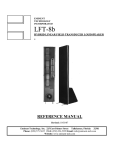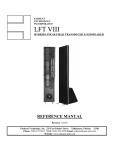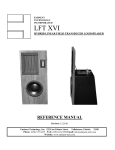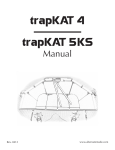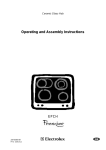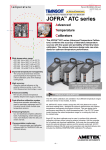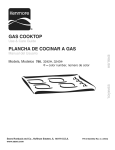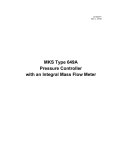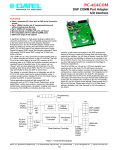Download Eminent LFT-10 Specifications
Transcript
A complete technical description of the LFT-6 is included in this manual and begins on page 8. It is recommended that you become familiar with this information as a thorough understanding of the LFT principals will assist you in the proper set up of these loudspeakers. Installation of the LFT - 6 Position the box on its side and open the end of the shipping carton. Remove the padding from the bottom and slide the speaker from the box as shown below. Unpacking the Speakers Open After removing the speaker from its carton it can be leaned against a wall standing up or placed with the front face of the speaker flat on the carpet. Then the bubble wrap should be removed. The wrap also holds the baffles (black triangular boards) and the grill cloth (covered by a large cardboard sheet) to the speaker. After the wrap is removed these will separate from the speaker. Do not attempt to remove or loosen hardware on the drivers themselves. The magnents are held together under great force and personal injury could result. 1 Speaker Assembly Assemble the feet and baffles with the speaker lying front face down on the carpet. Use the drawing below to identify the correct hardware locations. Grill cloths snap into place with velcro fasteners at each corner on the front and back of the speaker. 10-32 x 3/4 Socket Head Screw (6) 10-32 x 3/4 Socket Head Screw (2) 10-32 x 3/4 Socket Head Screw (4) It may help to have two people remove the speakers from the boxes because of their weight . 2 Speaker placement is critical for correct imaging, frequency balance, low frequency performance, and efficiency. Positioning the Speakers in the listening room Low frequency performance in particular can be determined by the shape of the room and the speaker's distance from the wall immediately behind them. Typically, the optimal distance between the LFTs and the rear wall is 2 to 5 feet in an average room. Because the diaphragm of the LFT-6 is very low in mass relative to the air around it, the air can act to mass-load the diaphragm, preventing large physical excursions required for deep bass reproduction; this effect occurs when the speaker is too close to the rear wall. The LFT-6 comes with one felt pad applied to the back of each panel. These pads are used to reduce the amplitude (Q) of the bump int the low frequency responce of each panel. Each panel has a diffrent resonance frequency in an attempt to smoth the low frequency response of the speaker. In general all three felt pads may not be necessary. This will depend on the room and listening position. A general rule would be if more bass output is desired from the speaker, remove felt pads, and if less bass output is desired, add felt pads. If you need more than is supplied with each speaker contact the factory. The above is not, however, the only consideration in determining the best distance between the LFTs and the wall behind them. At certain exact distances from the wall behind them, dipole speakers can exhibit multiple low-frequency cancellation effects, causing bumpy, “comb-filter”-like bass response. At the same time, low-frequency information can be reinforced by experimenting with the distance between the listening area and the wall behind it. Generally, if the listener is seated close to the wall behind him, there will be more apparent low frequency information; as the listener moves away from the wall behind him, toward the center of the room, low frequency reinforcement will decrease. Trial and error remains the best way to sort things out and achieve the best bass response; there are no hard and fast rules. 3 Felt Dampers Overall Balance and Toe-In The overall frequency balance of the LFT-6 is somewhat affected by the degree to which the speakers are toed in toward the central listening position. The on-axis frequency response of the LFTs is essentially flat, and it is often best to position the speakers so that the main listening position is about on axis with each speaker. 2 TO 5 FEET 2 TO 5 FEET SEE TEXT FOR DISTANCE The Listening Room Slight midrange frequency balance changes can be obtained by pointing the speakers slightly away from the listening position. This balance can also be altered by adjusting the speakers’ degree of vertical tilt with the pointed feet. 4 The high frequency performance of the LFTs can be tailored with the tweeter lever control. A jumper is mounted under the crossover cover. There are three tweeter level positions. If the jumper is disconnected, the treble energy is rolled off slightly and this is the lowest setting. When the jumper is connected to the third terminal up from the bottom of the right hand row of six terminal points, the tweeter output at its middle position. The highest tweeter level setting is achieved when the jumper is moved up one terminal to the fourth one. It is best to start with the tweeter level jumper disconnected, position the speakers for the best overall frequency balance, and the decide if more high frequency energy is needed. The Tweeter Level Control Overall imaging depends primarily on the distance separating the two speakers relative to their distance from the preferred listening position; it is also affected by the degree of toe-in. We cannot accurately predict what will work best in your listening room, and can suggest only that you begin with the drawing on the previous page as a starting point or general guideline. Keep in mind that the parameters that affect frequency balance also tend to affect imaging properties, and vice versa, so it is best to adjust speaker placement in small increments and to note carefully all of the changes effected by each shift in position before proceeding further. Imaging The LFT-6 is wired for 6-Ohm operation, and is appropriate for use with most higher-powered tube and solid-state amplifiers. The efficiency is 83dB with a 2.83 volt drive (1 “8” Ohm watt). This efficiency rating is lower than average. However, the LFT radiates a planar wavefront, and as such its apparent efficiency at the listening position is higher than the numerical rating implies. The LFT-6 has a minimum requirement of 100 watts per side, whether tube or solid-state. It can handle “music power” levels (short-term bursts) of 500 watts or more without difficulty. In general, the limit of the speaker is only reached when the diaphragm actually “bottoms out” against the magnets. Amplifier Requirements The above minimum requirements are really only estimates and depend on listening taste and the listening environment. More power will be required if the listening room is large, or if average sound pressure levels higher than 90 dB are desired. 5 Bi-Wiring and BiAmping The LFT-6is configured to allow bi-wiring or bi-amping with a minimum of trouble. The two pairs of inputs on the crossover are connected together internally, hot to hot and ground to ground. During normal use, speaker cables can be connected to either the top or bottom pair of inputs. Cutting the Terminal Jumpers For bi-wiring or bi-amping, the internal jumpers connecting the upper and lower input terminals must be severed. Remove the four phillips-head screws that hold the crossover cover in place and carefully remove the cover; there is just enough slack in the wiring between the speaker and the cover to allow this. Sever the two jumper wires with cutting pliers and bend them slightly so they cannot contact one another or touch the metal cover. Severing the jumpers divides the inputs so that now the lower terminals power the low /midfrequency drivers, and the upper terminals power the high frequency drivers. Both pairs of inputs continue to power their drivers through the internal crossover, which cannot be bypassed. TWEETER INPUT MID/WOOFER INPUT JUMPERS INSIDE Bi-wiring simply means connecting a single stereo amplifier (or two mono amps) to a pair of speakers by using two pairs of speaker cables. Connect the hot and ground conductors of a pair of cables to the same output terminals on one channel of the amplifier; the other ends are connected to the now-separate woofer/mid and tweeter inputs of the LFT. (All speaker cables should be the same length.) The effects of bi-wiring tend to be subtle, the slight improvement may be worth the relatively modest cost of an extra pair or speaker cables. Bi-wiring also permits experimenting with different types of cables for the two inputs; you may find that one type is best-suited for bass\mid performance, while another works best on the treble side. 6 Bi-amping requires and additional stereo amplifier or pair of mono amps. You will also need some means of insuring that only the desired portion of the frequency range reaches each amplifier. The simplest way to accomplish this is with an external electronic crossover; however, this can also be done by hard-wiring low-pass and high-pass filters into the inputs of the bass/mid and treble amplifiers, respectively. For the low/midfrequency amp, a 10kHz low-pass filter (6 dB/octave) is required; for the treble amp, a 10kHz. high-pass filter (also 6 dB/octave) is required. If you wish to pursue this method, your dealer or the manufacturer of your amplifiers should be able to help you determine the specific parts necessary. Note that you will also need a level control on either one of the stereo amps or on the crossover, regardless of which approach you take to biamping. 7 Bi-Amping Technical Description The Eminent Technology Linear Field Transducer is a full-range, push-pull, dynamic planar loudspeaker. In a sense, it is the magnetic equivalent of a push-pull electrostatic loudspeaker, differing in that it requires no step-up transformer or bias voltage, and that the audio signal is applied directly to its diaphragm. the LFT-VI To fully understand the strengths of the LFT design, one must first consider the design and operation of this speaker's three most notable 8 antecedents: the push-pull electrostatic loudspeaker (ESL); the traditional, single-ended planar magnetic loudspeaker, and the ribbon loudspeaker. 9 Electrostatic Loudspeakers The electrostatic starts with a very thin (half mil or less) diaphragm made of mylar or a similar material, to which a light coating of mildly conductive substance such as graphite has been applied. This diaphragm is suspended on a rigid frame and sandwiched between two stationary conductive grids (usually perforated metal plates) called stators. FRAME FRONT STATOR REAR STATOR [PERFORATED METAL PLATE] CONDUCTIVE DIAPHRAM TO BIAS VOLTAGE SUPPLY RESISTOR TO AMPLIFIER TRANSFORMER -+ A DC charge of high voltage (in the thousands of volts) but very low current, known as the bias voltage, is applied to the conductive diaphragm and kept constant. A step-up transformer is introduced to increase the usable voltage of the amplifier's output (while simultaneously decreasing the current), and the two ends of the transformer's output coil are connected to the two stators. As the amplifier produces a continuously varying AC voltage, (the amplified music signal), the charge on the two stators will also continuously change in synchronization with the music; and since the two stators are connected to two different ends of the transformer's output, one stator will take on a predominantly negative charge at the same time and to the same extent that the other stator takes on a predominantly positive charge. The constant-charge diaphragm will thus undergo a continuously changing state of attraction to and repulsion from the two stators as their polarization changes, and it is this motion that excites the air to the front and rear of the speaker and produces sound. 10 The traditional planar magnetic also starts with a thin mylar diaphragm, one side of which is coated with adhesive and fitted with an aluminum wire voice grid, (analogous to the voice coil of a conventional cone driver). The diaphragm is held taut in a metal frame. On the front of this frame is a large sheet of perforated metal, to which rows of vertically aligned strip magnets have been fastened. FRAME DIAPHRAM S N PERMANENT STRIP MAGNETS VOICE GRID [ACTUALLY A CONTINUIOS LOOP] S N PERFORATED METAL SHEET S TO AMPLIFIER + SINGLE-ENDED PLANAR MAGNETIC [TOP VIEW CROSS-SECTION] Spacing exaggerated to show detail From there, the operation of a single-ended planar magnetic loudspeaker is remarkably similar to that of a conventional cone driver: The amplifier's output is sent directly through the voice grid and, because it is suspended within a stationary magnetic field, the grid moves back and forth within that field in synchronization with the AC voltage that is the amplified music signal. Since the voice grid is permanently fastened to a taut diaphragm, the diaphragm also moves in synchronization with the music signal, exciting the air and producing sound. 11 Planar Magnetic Loudspeakers Ribbon Loudspeakers The third and final antecedent to consider is the ribbon: a distinctly different sort of transducer, but one that is similar (in principle, at least) to the single-ended planar magnetic. The ribbon’s primary distinction is that its “diaphragm” and “voice element” are one and the same. A ribbon driver is based on a long, narrow strip of conductive material; in practice, thus far, all true ribbons have used a strip of very thin corrugated aluminum for this purpose. The two ends of this strip are electrically connected to the amplifier’s output, and are physically anchored such that the strip is suspended within a stationary magnetic field--with said magnets positioned at the edges of the strip. PERMANENT MAGNET N ALUMINUM RIBBON ELEMENT _ TO AMPLIFIER [LEADS CONNECTED TO TOP AND BOTTOM OF RIBBON ELEMENT] + S PERMANENT MAGNET RIBBON DRIVER [TOP VIEW CROSS-SECTION] The operating principle is straightforward from there: the amplifier’s output passes directly through the aluminum strip--which, because it is suspended within a permanent magnetic field, moves back and forth in synchronization with the signal, producing sound. 12 Not surprisingly, each of the approaches described above has its own unique set of pros and cons. The electrostatic, because its diaphragm is so thin and light, offers exceptionally good transient response and reproduction of subtle, low-level musical detail. And, because it is a true push-pull device (i.e., its diaphragm is, by design, driven from both the front and the rear), the ESL operates in a linear fashion. Typically, gross distortion results only when the driving amplifier clips into the speaker, or when, in an attempt to play the speaker louder than its design allows, its step-up transformer reaches a point of saturation. Evaluating Earlier Approaches Electrostatics On the negative side of the ledger, the ESL does require passing the amplified musical signal through a transformer, which can introduce its own colorations and non-linearities. Also, some ESLs are prone to a condition known as arcing: Under the conditions of stress induced by playing an ESL loudly, it is not uncommon for an electrical spark to jump between one stator and the diaphragm (a phenomenon exactly analogous to lightning), burning a minute hole in the diaphragm and, over time, ruining it. As for the planar magnetic, its strengths are similar to those of the ESL-although the addition of several feet of wire and an adhesive coat make for a somewhat more massive diaphragm, limiting this design’s transient capabilities by comparison. But the planar magnetic requires no step-up transformer or bias voltage supply, and it has the added benefit of being an extremely manageable load for most amplifiers. However, the most specific drawback of the traditional planar magnetic is that it is a singleended (as opposed to push-pull) device: As the diaphragm’s physical excursion increases, the voice grid moves further away from its optimal location within the permanent magnetic field (at least in one direction). Thus, at the very instant when this speaker is called upon to reproduce large-amplitude waveforms, it is least able to do so without distortion. Planar Magnetics In many ways, a ribbon driver can be an excellent performer: the moving element (the “ribbon” itself) is extremely light, allowing good “speed” and transient performance as well as freedom from coloration. And there is no significant physical structure on either side of the ribbon’s radiating pattern. The ribbon’s main problem is not one of performance but of application: it cannot be used to reproduce low frequencies. To create a moving element large enough to generate frequencies lower than a few hundred Hz would mean moving opposing magnetic poles so far apart that they would no longer exert a sufficient magnetic field over the entire area of the ribbon. Ribbons 13 Also, when a ribbon is operated at frequencies approaching the element’s own resonant frequency (which is naturally quite low, due to its high compliance), the ribbon element stretches and “bows” to a point where it is no longer within the magnetic gap. To get around either of these problems means to move the permanent magnet structure from the edges of the element to one entire side of the element, and/or to bond the element to a “host” diaphragm, such as a sheet of mylar, and to clamp that diaphragm around its perimeter. In either case the driver is no longer a ribbon; it is, in fact, a planar magnetic. To date, no one has succeeded in creating a full range ribbon loudspeaker. 14 Eminent Technology’s Linear Field Transducer, introduced as the LFT, represents a new approach to the design and construction of a high-quality loudspeaker*. It builds on the strengths of the above designs while eliminating many of their drawbacks. The Linear Field Transducer The construction of the LFT -6 begins by laminating a very thin sheet of aluminum foil to a half-mil-thick sheet of Mylar. A voice grid pattern, created by means of CAD (Computer-Aided Design) technology, is silkscreened onto the foil side; the remainder of the aluminum--the part not covered by ink from the silkscreening--is chemically etched away, in a manner similar to the etching of traces on a printed-circuit board. The ink is then washed away, leaving a voice grid of near-perfect uniformity. This technique results in a diaphragm/voice coil grid that is still less than one mil in total thickness, and also permits relatively narrow spaces between the individual traces, so the diaphragm can be evenly driven over its entire surface. Diaphragm Construction The magnet/frame structure developed for the LFT-6 is also unique. Eminent Technology builds its strip magnets into individual steel channels, the size and shape of which have been carefully designed to help “focus” the magnetic flux lines and concentrate the strength of the magnetic field on the appropriate area of the diaphragm/voice grid. These channels are then welded to steel crossbars (four per drive unit, vertically spaced 6-1/2 inches apart), which in turn are bolted to the aluminum frame that holds the diaphragm in place. The Magnet/Frame Structure Interestingly, one of the biggest challenges faced in creating a true pushpull dynamic speaker was not a design consideration but rather a matter of construction difficulty: to assemble a perfectly rigid structure with very powerful permanent magnets at the front and the rear, both sides opposing each other with tremendous force. It was not until Eminent Technology developed a special method for this assembly procedure that the Linear Field Transducer became a reality. * The design and construction of the LFT is patented. 15 By applying such new techniques to planar loudspeaker construction, Eminent Technology has been able to eliminate many of the flaws inherent in earlier designs. The use of a welded channel-and-crossbar frame dispenses with the need for perforated sheet metal (an “off-the-shelf” material presumably used for reasons of economy and ease of manufacture.) thus greatly improving dispersion, especially at high frequencies. FRAME DIAPHRAM N S PERMANENT STRIP MAGNETS N S VOICE GRID CONTINUOUS LOOPS N STEEL CROSS BAR S N _ TO AMPLIFIER S STEEL CHANNELS + LINEAR FIELD TRANSDUCER [TOP VIEW CROSS-SECTION] Spacing exaggerated to show detail Since it is now possible to have a powerful, precisely aligned magnet structure on both sides of the diaphragm, true push-pull operation has been achieved: Regardless of the degree of excursion the diaphragm undergoes, the voice element is always optimally positioned within the magnetic field. The result is extremely linear performance throughout the audible range, with a profound increase in dynamic range and an absolute minimum of distortion. 16 Each LFT has five individual driver panels. The outside portion on each panel is divided into separately driven bass and (line-source) midrange areas, with the former operating from 400 Hz down, and the latter operating from 400 Hz up to 10 kHz. The tweeters operate as a line source from 10 kHz up to and beyond 20 kHz. The midrange and tweeter sections are distinguishable by their thinner magnet structures. Panel Frequencies 10 KHz and above 400 to 10KHz To 400 Hz the LFT-IV Right Speaker All three panels operate as woofers, from 400 Hz on down. Actually, all of the panels, including the “woofers,” are physically capable of operating to beyond 20 kHz, but would exhibit undesirable diffraction effects and poor dispersion if allowed to do so, which is why the panels are segmented into different sections for different portions of the frequency range. The use of a flat panel design maintains excellent phase response throughout the audible range. The LFT-6 can be made to operate at almost any impedance; our present choice of a nominal 6-Ohm impedance has been made in the interest of maximizing efficiency and amplifier compatibility. Because of the large 17 LFT Impedance surface area of the panels and the resulting good heat dissipation (a function also of the material choice for the voice grid), the LFT-6 can handle tremendous amounts of power before any risk of damage. 18 Power Requirements: 100 watts minimum Sensitivity 83 dB (pink noise, 20-20 kHz) at 1 watt/1 meter (2.83 V) Frequency Response 38 Hz-20 kHz ±4 dB (typical room, close-mic measurement) -10 dB at 35 kHz Phase Accuracy ± 20° 100 Hz-31 kHz High Frequency Level Flat, -6 dB, -12 dB at 20 kHz smooth rolloff Impedance 6 Ohm rating Maximum SPL 105 dB at 1 meter Magnet type Ceramic 8 Diaphragm Area 420 in2 (front) Harmonic Distortion Less than .04%, 100 Hz-20 kHz, 90 dB, 1 meter Dimensions 18" wide by 78" high by 1" thick Shipping Weight 95 lbs. each Foil thickness .00033" Mylar thickness .0005" Laminate Adhesive Thickness .00015" Gap Between Conductors .03" Peak-to-Peak Diaphragm Displacement .4" Woofer .035 Tweeter Warranty 3 years parts, 1 year labor Finish Oak standard Walnut and other painted finishes optional Music All of the above done for the enjoyment of music. 19 Specifications David Collie and Bruce Thigpen Designers 20 Technical information 21 Technical information 22 Technical information 23 Technical information 24 Eminent Technology Inc. warrants the LFT Loudspeaker to be free from defects in materials and workmanship for a period of 30 days from the date of purchase. Within that period, any failure of the LFT will be corrected without charge for parts, labor, or transportation from the factory. After this period, pending receipt of the warranty form (filled out and mailed to Eminent Technology, and postmarked no later than one month after the date of purchase), the above warranty will be extended to three years for parts and one year for labor. This warranty is transferrable to subsequent owners, pending notification from the original owner, in writing, within 10 days of the personal sale. The obligation of Eminent Technology under the terms of this warranty does not extend to: 1. Any LFT installed or operated without regard for the instructions contained in this manual. 2. Any LFT while under performance testing, or after being used in such a test, by any personnel or facility not authorized by Eminent Technology. 3. Any other component or part connected to or operated in conjunction with the LFT. 4. Any traumatic, accidental damage, or damage incurred in shipping, or defects which upon examination by Eminent Technology and in its sole opinion have been caused by abuse, neglect, improper or abnormal installation, or operation for extended periods in industrial applications. This warranty is not applicable if any part of the LFT has been removed or taken apart, repaired, altered, or modified by anyone without prior authorization in writing from Eminent Technology, nor if the serial numbers have been defaced or rendered illegible. If an Eminent Technology product is removed from the country in which the original consumer purchase was made, Eminent Technology dealers and distributors in other countries are not obligated by the terms of this warranty. Eminent Technology reserves the right to incorporate design refinements and changes to its products without notice or obligation. If practical, such design modifications will be made available to owners of existing units for a reasonable charge. Under the terms of this warranty, Eminent Technology expressly does not insure for loss of use of the LFT due to failure or periods of repair. Warranty repairs will be carried out by the factory. The LFT must be returned prepaid in its original factory carton to: Eminent Technology, Inc 225 East Palmer Street Tallahassee, FL 32301 (904) 224-5999 25 Warranty

























